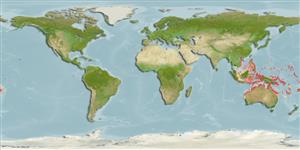>
Acanthuriformes (Surgeonfishes) >
Siganidae (Rabbitfishes)
Etymology: Siganus: Latin, siganus = a fish, rabbit fish; by the similarity of the nose (Ref. 45335).
Issue
Cuvier in Guérin-Méneville, circa 1830.
Environment: milieu / climate zone / depth range / distribution range
Ecologia
marinhas associadas(os) a recifes; intervalo de profundidade 0 - 15 m (Ref. 90102). Tropical; 20°N - 29°S, 102°E - 174°W
Western Pacific: scarcely entering the Indo-Malayan area (except eastern Indonesia), north to Palau and Kosrae, south to northwestern Australia and Tonga (Ref. 43045). Replaced by closely related Siganus virgatus from Sulawesi and the Philippines to south India (Ref. 37816).
Tamanho / Peso / Idade
Maturity: Lm ? range ? - ? cm
Max length : 25.0 cm SL macho/indeterminado; (Ref. 48637); common length : 20.0 cm TL macho/indeterminado; (Ref. 9813)
Espinhos dorsais (total) : 13; Raios dorsais moles (total) : 10; Espinhos anais: 7; Raios anais moles: 9; Vértebras: 13. Body blue above, silvery white below; from nape through eye to chin a seal brown band, another from base of 4th-5th dorsal spines to just below of pectoral fin. Spines stout, pungent and venomous. Preopercular 97°-110°. Strong scales cover cheeks. Midline of thorax fully scaled; sometimes a few scales absent from pelvic ridges.
Inhabits coral-rich areas of lagoons and seaward reefs. Juveniles form schools. Pairs form at 7 cm; but these pairs continue to form loose schools, sometimes with juvenile scarids, to feed in areas being flooded by the tide. At 20 cm, isolated pairs in deep water lagoons or on drop-offs at reef-edges feed on benthic seaweeds (Ref. 9813, 48637). Anterolateral glandular grooves with venom gland (Ref. 57406). Very closely related to the blue-spotted S. virgatus (Valenciennes) and apparently hybridizes at times with it in the Indo-Malayan region (Ref. 2334). Minimum depth reported taken from Ref. 128797.
Life cycle and mating behavior
Maturidade | Reprodução | Desova | Ovos | Fecundidade | Larvas
Woodland, D.J., 1990. Revision of the fish family Siganidae with descriptions of two new species and comments on distribution and biology. Indo-Pac. Fish. (19):136 p. (Ref. 1419)
Categoria na Lista Vermelha da IUCN (Ref. 130435: Version 2024-1)
Utilização humana
Pescarias: pouco comercial
Ferramentas
Relatórios especiais
Descarregue XML
Fontes da internet
Estimates based on models
Preferred temperature (Ref.
123201): 25.5 - 29.3, mean 28.6 °C (based on 1956 cells).
Phylogenetic diversity index (Ref.
82804): PD
50 = 0.5000 [Uniqueness, from 0.5 = low to 2.0 = high].
Bayesian length-weight: a=0.01349 (0.00803 - 0.02267), b=3.11 (2.97 - 3.25), in cm total length, based on LWR estimates for this species & Genus-body shape (Ref.
93245).
Nível Trófico (Ref.
69278): 2.0 ±0.00 se; based on food items.
Resiliência (Ref.
120179): Elevada, tempo mínimo de duplicação da população menor que 15 meses (Preliminary K or Fecundity.).
Fishing Vulnerability (Ref.
59153): Low vulnerability (21 of 100).
Nutrients (Ref.
124155): Calcium = 46.6 [23.3, 110.7] mg/100g; Iron = 0.739 [0.348, 1.700] mg/100g; Protein = 18.5 [17.0, 20.0] %; Omega3 = 0.0989 [, ] g/100g; Selenium = 18.4 [7.3, 46.3] μg/100g; VitaminA = 35.5 [8.3, 144.5] μg/100g; Zinc = 1.52 [0.59, 3.25] mg/100g (wet weight);
